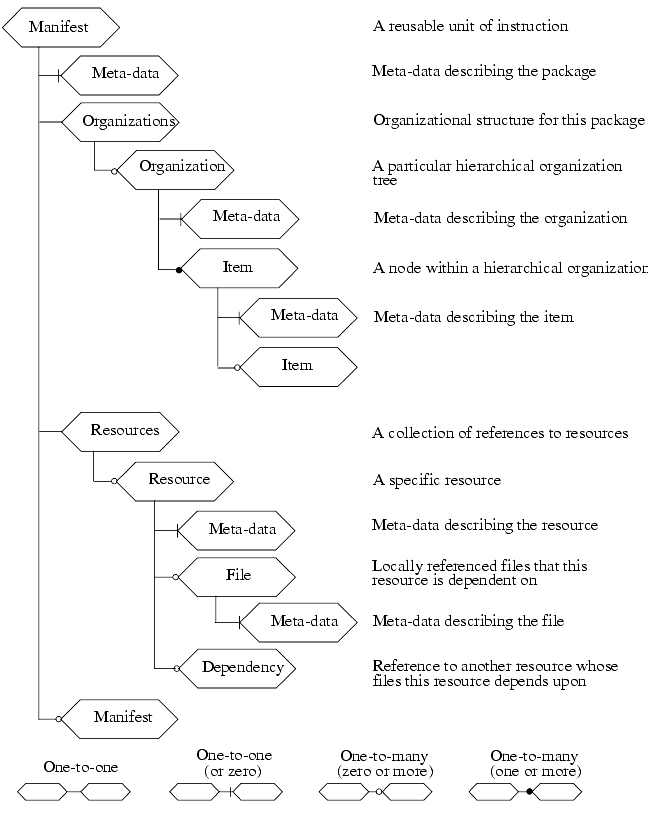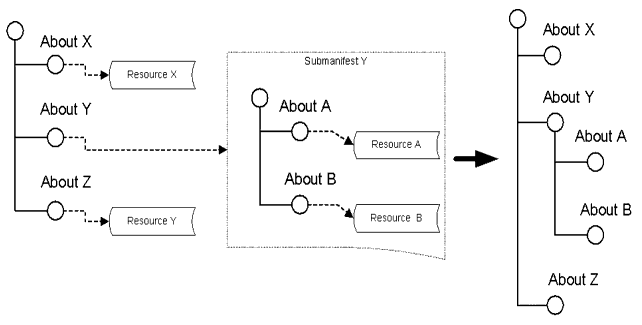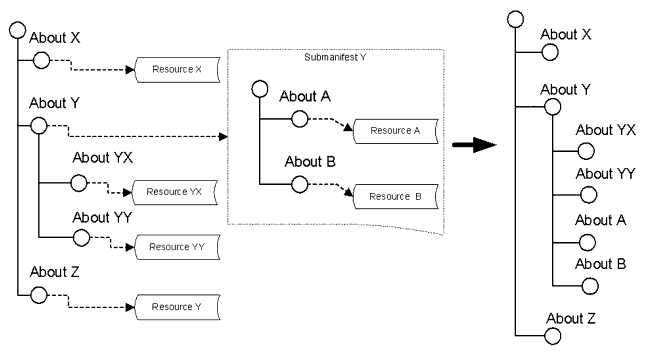 |
1EdTech Content Packaging Information Model Version 1.1.2 Final Specification |
| Copyright © 2001 1EdTech Consortium, Inc. All Rights Reserved. The 1EdTech Logo is a trademark of 1EdTech Consortium, Inc. Document Name: 1EdTech Content Packaging Information Model Revision: 8 August 2001
IPR and Distribution Notices Recipients of this document are requested to submit, with their comments, notification of any relevant patent claims or other intellectual property rights of which they may be aware that might be infringed by any implementation of the specification set forth in this document, and to provide supporting documentation. 1EdTech takes no position regarding the validity or scope of any intellectual property or other rights that might be claimed to pertain to the implementation or use of the technology described in this document or the extent to which any license under such rights might or might not be available; neither does it represent that it has made any effort to identify any such rights. Information on 1EdTech's procedures with respect to rights in 1EdTech specifications can be found at the 1EdTech Intellectual Property Rights web page: http://www.imsglobal.org/ipr/imsipr_policyFinal.pdf. Copyright © 2001 1EdTech Consortium. All Rights Reserved. Permission is granted to all parties to use excerpts from this document as needed in producing requests for proposals. Use of this specification to develop products or services is governed by the license with 1EdTech found on the 1EdTech website: http://www.imsglobal.org/license.html. The limited permissions granted above are perpetual and will not be revoked by 1EdTech or its successors or assigns. THIS SPECIFICATION IS BEING OFFERED WITHOUT ANY WARRANTY WHATSOEVER, AND IN PARTICULAR, ANY WARRANTY OF NONINFRINGEMENT IS EXPRESSLY DISCLAIMED. ANY USE OF THIS SPECIFICATION SHALL BE MADE ENTIRELY AT THE IMPLEMENTER'S OWN RISK, AND NEITHER THE CONSORTIUM, NOR ANY OF ITS MEMBERS OR SUBMITTERS, SHALL HAVE ANY LIABILITY WHATSOEVER TO ANY IMPLEMENTER OR THIRD PARTY FOR ANY DAMAGES OF ANY NATURE WHATSOEVER, DIRECTLY OR INDIRECTLY, ARISING FROM THE USE OF THIS SPECIFICATION. |
Table of Contents
1. Introduction
1.1 Overview
The 1EdTech Content Packaging Information Model describes data structures that are used to provide interoperability of Internet based content with content creation tools, learning management systems (LMS), and run time environments.
The objective of the 1EdTech Content Packaging Information Model is to define a standardized set of structures that can be used to exchange content. These structures provide the basis for standardized data bindings that allow software developers and implementers to create instructional materials that interoperate across authoring tools, LMSs, and run time environments that have been developed independently by various software developers.
Note: The scope of the 1EdTech Content Packaging specification is focused on defining interoperability between systems that wish to import, export, aggregate, and disaggregate Packages of content. Future documents comprising the 1EdTech Content specification will address requirements regarding content data models and communication between run time environments and LMSs.
1.2 Scope & Context
This document is the 1EdTech Content Packaging (CP) Information Model specification. As such it will be used as the basis for the production of the following documents:
1.3 Structure of this Document
The structure of the rest of this document is:
1.4 Nomenclature
| CDATA | Character Data |
| CPI | Content & Packaging Interchange |
| DTD | Document Type Definition |
| PCDATA | Parsed Character Date |
| W3C | World Wide Web Consortium |
| XML | Extensible Mark-up Language |
2. 1EdTech Content Packaging Conceptual Model
In Figure 2.1 is a conceptual diagram that illustrates the components of the 1EdTech Content Packaging Information Model. As indicated in the 1EdTech Content Packaging Best Practice Guide, this is part of the larger 1EdTech Content Framework, which forms the basis for this and future specifications.

2.1 Key Elements
The 1EdTech Package depicted in Figure 2.1 consists of two major elements: a special XML file describing the content organization and resources in a Package, and the physical files being described by the XML. The special XML file is called the 1EdTech Manifest file, because course content and organization is described in the context of 'manifests'. Once a Package has been incorporated into a single file for transportation, it is called a Package Interchange File. The relationship of these parts to the content container is described below:
Package Interchange File - a single file, (e.g., .zip, .jar, .cab) which includes a top-level manifest file named "imsmanifest.xml" and all other physical files as identified by the Manifest. A Package Interchange File is a concise Web delivery format, a means of transporting related, structured information. PKZip v2.04g (.zip) is recommended as the default Package Interchange File format.
Package - a logical directory, which includes a specially named XML file, any XML control documents it references (such as a DTD or XSD file), and sub-directories containing the actual physical resources.
- Top-level Manifest - a mandatory XML element describing the Package itself. It may also contain optional (sub)Manifests. Each instance of a manifest contains the following sections:
- Meta-data section - an XML element describing a manifest as a whole.
- Organizations section - an XML element describing zero, one, or multiple organizations of the content within a manifest.
- Resources section - an XML element containing references to all of the actual resources and media elements needed for a manifest, including meta-data describing the resources, and references to any external files.
- (sub)Manifest - one or more optional, logically nested manifests.
- Physical Files - these are the actual media elements, text files, graphics, and other resources in their various sub-directories as described by the manifest(s).
Package - A Package represents a unit of usable (and reusable) content. This may be part of a course that has instructional relevance outside of a course organization and can be delivered independently, as an entire course or as a collection of courses. Once a Package arrives at its destination to a run time service, such as an LMS vendor, the Package must allow itself to be aggregated or disaggregated into other Packages. A Package must be able to stand-alone; that is, it must contain all the information needed to use the contents for learning when it has been unpacked.
Packages are not required to be incorporated into a Package Interchange File. A Package may also be distributed on a CD-ROM or other removable media without being compressed into a single file. An 1EdTech Manifest file and any other supporting XML files required by it (DTD, XSD) must be at the root of the distribution medium.
Manifest - A manifest is a description in XML of the resources comprising meaningful instruction. A manifest may also contain zero or more static ways of organizing the instructional resources for presentation.
The scope of manifest is elastic. A manifest can describe part of a course that can stand by itself outside of the context of a course (an instructional object), an entire course, or a collection of courses. The decision is given to content developers to describe their content in the way they want it to be considered for aggregation or disaggregation. The general rule is that a Package always contains a single top-level manifest that may contain one or more (sub)Manifests. The top-level manifest always describes the Package. Any nested (sub)Manifests describe the content at the level to which the (sub)Manifest is scoped, such as a course, instructional object, or other.
For example, if all content comprising a course is so tightly coupled that no part of it may be presented out of the course context, a content developer would want to use a single manifest to describe that course's resources and organization. However, content developers who create "instructional objects" that could be recombined with other instructional objects to create different course presentations would want to describe each instructional object in its own manifest, then aggregate those manifests into a higher-level manifest containing a course organization. Finally, a content developer who wants to move multiple courses in a single Package (a curriculum), would use a top-level manifest to contain each course-level manifest and any instructional object manifests that each course might contain.
Resource - The resources described in the manifest are physical assets such as web pages, media files, text files, assessment objects or other pieces of data in file form. Resources may also include assets that are outside the Package but available through a URL, or collections of resources described by (sub)Manifests. The combination of resources is generally categorized as content. Each resource may be described in a <resource> element within a manifest's XML. This element includes a list of all the assets required to use the resource. The files included in the Package are listed as <file> elements within such <resource> elements.
2.2 Standard Name for the Manifest File
Content distributed according to the 1EdTech Content Packaging specification must contain an 1EdTech Manifest file. To ensure that the 1EdTech Manifest file can always be found within a Package, it has a pre-defined name and location:
imsmanifest.xml
The 1EdTech Manifest file and any of its supporting XML files (DTD, XSD) must be placed at the root of the Package Interchange File or any other packaging image (like a CD-ROM).
In the absence of this file, the package is not an 1EdTech Package and cannot be processed. It is required that the name be kept, as above, in all lowercase letters.
3. Extensibility
An important underpinning of the 1EdTech Content Packaging specification is rich support for extensibility. While the base Content Packaging Information Model leverages the rich set of meta-data elements defined in the 1EdTech Meta-Data Specification v1.2, it defines only the basic structures for organization and resources (Web Content). It is expected that implementers of this specification will define new types of resources and organizations to describe and transport rich learning resources, and over time, it may be possible to incorporate widely used extensions into future versions of this specification.
4. Manifest Elements
This section provides a conceptual, informative description of the elements contained in a Manifest. Figure 4.1 illustrates the primary elements of a Manifest.

The table below provides a conceptual, informative description of the data objects. The columns used in the table refer to:
Note: Additional descriptive information about the element.
- In the table below, the Manifest elements contained in the Content Packaging Information Model are described using mixed case to enhance readability. Implementers of this specification should refer to particular binding specifications. For example, some XML bindings follow the W3C convention of using lowercase for all elements.
- Elements surrounded by braces ({}) indicate areas in the Information Model where elements from other information models or specifications are expected to be included.
4.1 (Sub)Manifests
When the identifierref of an <item> in an <organization> references a (sub)Manifest rather than another type of resource, this shall be interpreted as follows:
- If the (sub)Manifest does not include any <organization>, the reference cannot be resolved. This shall be treated as a null identifierref.
- If the (sub)Manifest includes an <organization> that can be used by the context in which the content is used, the root node of that organization (i.e., the <organization> element itself) shall merge with the <item> that references the (sub)Manifest, if the <item> becomes instantiated. If the same attribute is specified for both the <item> and the <organization>, but with different values, the value defined for the <item> manifest shall override the value defined for the <organization>.
The diagram in Figure 5.1 explains how the content of a (sub)Manifest is virtually merged with the content of a referencing manifest. The circles represent <items> in an <organization> structure.

In Figure 5.2, the diagram explains how the content of a (sub)Manifest is merged with an <item> that has children of its own, and how the referencing <item>'s children take precendence over those they merge with.

Appendix A - List of Contributors
The following individuals contributed to the development of this specification:
About This Document
| Title | 1EdTech Content Packaging Information Model |
| Editors | Thor Anderson, Mark McKell |
| Team Co-Lead | Adam Cooper (Fretwell-Downing) |
| Version | 1.1.2 |
| Version Date | August 2001 |
| Status | Final Specification |
| Summary | This document describes the 1EdTech Content Packaging Information Model, which is used to support content interoperability between different authors, publishers and other corresponding content developers. |
| Revision Information | 8 August 2001 |
| Purpose | Defines the Content Packaging Information Model |
| Document Location | http://www.imsglobal.org/content/packaging/ |
Revision History
Index
A
Aggregation 1
D
DTD 1
E
Editors 1
Elements
Default 1
Dependency 1
File 1
HRef 1
Identifier 1, 2
IdentifierRef 1, 2
IsVisible 1
Item 1
Manifest 1, 2
Meta-data 1, 2
Organization 1
Parameters 1
Resource 1
Resources 1
Schema 1
SchemaVersion 1
Structure 1
Title 1, 2
Type 1
Version 1
extensibility 1
I
1EdTech Manifest File 1
1EdTech Manifest file 1
imsmanifest.xml 1, 2
O
Organizations 1
P
Package 1, 2
Package Interchange File 1, 2
R
Resource 1
Revision History 1
run time environment 1
S
scope 1
sub-Manifest 1, 2, 3
W
W3C 1
X
XML 1
Z
zip 1
1EdTech Consortium, Inc. ("1EdTech") is publishing the information contained in this 1EdTech Content Packaging Information Model ("Specification") for purposes of scientific, experimental, and scholarly collaboration only.
1EdTech makes no warranty or representation regarding the accuracy or completeness of the Specification.
This material is provided on an "As Is" and "As Available" basis.
The Specification is at all times subject to change and revision without notice.
It is your sole responsibility to evaluate the usefulness, accuracy, and completeness of the Specification as it relates to you.
1EdTech would appreciate receiving your comments and suggestions.
Please contact 1EdTech through our website at http://www.imsglobal.org
Please refer to Document Name: 1EdTech Content Packaging Information Model Revision: 8 August 2001


